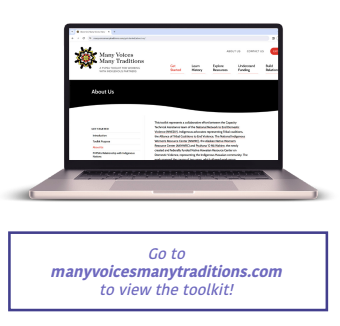Many Voices, Many Traditions: A FVPSA Toolkit for Working With Indigenous Partners
As advocates, our goal is to end domestic and sexual violence. In 2017, a group of staff from The National Network to End Domestic Violence (NNEDV), The National Indigenous Women’s Resource Center (NIWRC), and the Family Violence Prevention and Services Act (FVPSA) had a discussion at the Domestic Violence Resource Network (DVRN) meeting that led to the idea to create a practical guide for FVPSA state administrators and state domestic violence coalitions on engaging and working with Tribal communities, programs, and coalitions.
Why focus on Tribal communities, programs, and coalitions? There are so many underserved populations that deserve equal access to quality services. This is a true statement that no one can deny or argue with. However, there was a recognition in this conversation that achieving the goal of ending violence can only happen if we focus on engaging and working with Tribal communities, who often have the least access to resources. If we, as a field, can assist those who have the least access to resources and services, then, as a field, we would be able to reach every survivor and every community. The outcome of that conversation was the creation of this toolkit.
The Process
A working group convened by NNEDV, comprised of representatives from Tribal coalitions, the Alliance of Tribal Coalitions to End Violence (ATCEV),NIWRC, the Alaska Native Women’s Resource Center (AKNWRC), and the Pouhana O Nā Wāhine (PONW), the newly created and federally funded Native Hawaiian Resource Center on Domestic Violence.
From the beginning, there was a commitment to centering the voices of Tribal advocates and the experiences of Indigenous Nations. This group of dedicated advocates brought the toolkit to life by sharing their histories and stories, and by identifying culturally specific resources.
The workgroup also agreed that the guide should provide practical information. The purpose of the toolkit is to assist administrators and state coalition staff with fulfilling the requirement from FVPSA to forge meaningful partnerships with Indigenous communities and support and fund services for Native survivors of domestic violence and their children.
The needs of American Indian, Alaska Native, and Native Hawaiian (AI/AN & NH) communities were identified through technical assistance calls, webinars, listserv conversations, and other meetings that were held over the years. Members of the workgroup recounted a multitude of expressed needs for resources from state coalitions and FVPSA state administrators and what they would like non-Native advocates and partners to know to better serve and partner with Tribal programs and support AI/AN & NH survivors of domestic violence.
The Focus
As the two primary state-based entities responsible for supporting and engaging AI/AN & NH communities, state domestic violence coalitions (SDVC) and FVPSA state administrators have a clear need to have a deeper understanding of Tribal Nations in their states. These two entities are required by FVPSA to work with, outreach to, and support AI/ AN & NH survivors of domestic violence and AI/AN & NH programs, regardless of a Tribe’s federal or state recognition status.
The toolkit is divided into sections that correspond to the information that state domestic violence coalitions and FVPSA state administrators need to begin to understand Tribal Nations and learn ways to engage. While no single document or source can cover the history of AI/AN & NH peoples, one of the goals of this project was to be a starting point for learning about the AI/AN & NH communities in each state.
As the toolkit came together, it became apparent that information was necessary for Tribal programs on how to access funding from both the state and federal governments. While it is important for Tribal programs to understand how to access funds, it is even more important for states and coalitions to work to provide funding opportunities for Tribal Programs and Native Hawaiian programs.
How to Use the Toolkit
The toolkit includes sections on the history of Tribal Nations, with break-out sections for Hawaii and Alaska, funding, statewide needs assessments, and state planning, and a section specifically for SDVCs on how to reach out to engage and partner with Tribal programs and Tribal coalitions. Each section is written in an FAQ style to make it easier for the reader to find what they are looking for and digest the information. It is the hope of the workgroup that advocates and administrators will take the time to go through the history section as that provides a context on how racism and colonialism have and continue to impact AI/AN & NH peoples.
At the end of the toolkit, there is a glossary of terms that are important to understand the language and terms to use when working with communities that are not our own. Using correct terminology is one way to show respect.
It should be acknowledged that no one source can cover everything you need to know about a particular Tribal Nation, nor can it fully cover the general history of trauma and atrocities that AI/AN & NH peoples have suffered, but it is our hope that this toolkit represents a starting point for learning and provides a foundation to outreach to, fund, engage and partner with Tribal Nations in your state.
The Future
It is the vision of the working group that the toolkit becomes a go-to resource for domestic violence coalition staff, advocates, and FVPSA state administrators when looking for information on outreach, engagement, and partnering to fund AI/AN & NH programs. The toolkit will be updated yearly to ensure that it stays a current and useful website.






